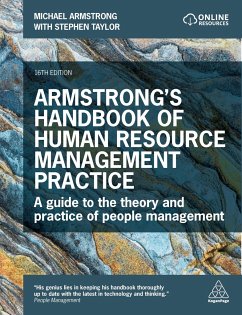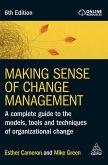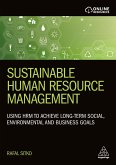Michael Armstrong, Stephen Taylor
Armstrong's Handbook of Human Resource Management Practice
A Guide to the Theory and Practice of People Management
Michael Armstrong, Stephen Taylor
Armstrong's Handbook of Human Resource Management Practice
A Guide to the Theory and Practice of People Management
- Gebundenes Buch
- Merkliste
- Auf die Merkliste
- Bewerten Bewerten
- Teilen
- Produkt teilen
- Produkterinnerung
- Produkterinnerung
Gain a complete understanding of how to develop all the key areas of the HR function with this one-stop shop handbook by the UK's bestselling HRM author.
Andere Kunden interessierten sich auch für
![Armstrong's Handbook of Strategic Human Resource Management Armstrong's Handbook of Strategic Human Resource Management]() Michael ArmstrongArmstrong's Handbook of Strategic Human Resource Management134,99 €
Michael ArmstrongArmstrong's Handbook of Strategic Human Resource Management134,99 €![Armstrong's Essential Human Resource Management Practice Armstrong's Essential Human Resource Management Practice]() Michael ArmstrongArmstrong's Essential Human Resource Management Practice55,99 €
Michael ArmstrongArmstrong's Essential Human Resource Management Practice55,99 €![Armstrong's Handbook of Learning and Development Armstrong's Handbook of Learning and Development]() Michael ArmstrongArmstrong's Handbook of Learning and Development191,99 €
Michael ArmstrongArmstrong's Handbook of Learning and Development191,99 €![Making Sense of Change Management Making Sense of Change Management]() Esther CameronMaking Sense of Change Management103,99 €
Esther CameronMaking Sense of Change Management103,99 €![Sustainable Human Resource Management Sustainable Human Resource Management]() Rafal SitkoSustainable Human Resource Management156,99 €
Rafal SitkoSustainable Human Resource Management156,99 €![Handbook of International Human Resource Management Handbook of International Human Resource Management]() Paul SparrowHandbook of International Human Resource Management122,99 €
Paul SparrowHandbook of International Human Resource Management122,99 €![Human Resource Management in Project-Based Organizations Human Resource Management in Project-Based Organizations]() Karin BredinHuman Resource Management in Project-Based Organizations76,99 €
Karin BredinHuman Resource Management in Project-Based Organizations76,99 €-
-
-
Gain a complete understanding of how to develop all the key areas of the HR function with this one-stop shop handbook by the UK's bestselling HRM author.
Produktdetails
- Produktdetails
- Verlag: Kogan Page / Kogan Page Ltd
- 16th edition
- Seitenzahl: 760
- Erscheinungstermin: 3. Januar 2023
- Englisch
- Abmessung: 251mm x 192mm x 36mm
- Gewicht: 1464g
- ISBN-13: 9781398606654
- ISBN-10: 1398606650
- Artikelnr.: 63934868
- Herstellerkennzeichnung
- Libri GmbH
- Europaallee 1
- 36244 Bad Hersfeld
- gpsr@libri.de
- Verlag: Kogan Page / Kogan Page Ltd
- 16th edition
- Seitenzahl: 760
- Erscheinungstermin: 3. Januar 2023
- Englisch
- Abmessung: 251mm x 192mm x 36mm
- Gewicht: 1464g
- ISBN-13: 9781398606654
- ISBN-10: 1398606650
- Artikelnr.: 63934868
- Herstellerkennzeichnung
- Libri GmbH
- Europaallee 1
- 36244 Bad Hersfeld
- gpsr@libri.de
Michael Armstrong is the UK's bestselling author of Human Resource Management books including Armstrong's Handbook of Human Resource Management Practice, Armstrong's Handbook of Strategic Human Resource Management, Armstrong's Handbook of Reward Management Practice and Armstrong's Handbook of Performance Management and several other titles published by Kogan Page. His books have sold over a million copies and have been translated into twenty-one languages. Michael Armstrong is a Companion and former Chief Examiner of the Chartered Institute of Personnel and Development (CIPD), a managing partner of E-Reward and an independent management consultant. Prior to this he was an HR director of a publishing company. He is based in London, UK.
Section
One: Fundamentals of human resource management; Chapter
01: The essence of HRM; Chapter
02: Human capital management; Chapter
03: The context of HRM; Chapter
04: The future of work; Chapter
05: HRM and organizational performance; Chapter
06: The ethical dimension of HRM; Chapter
07: Corporate social responsibility; Section
TWO: The strategic approach to HRM; Chapter
08: Strategic HRM; Chapter
09: HR strategy; Section
THREE: Delivering HR; Chapter
10: The role of HR; Chapter
11: The HRM role of line managers; Section
FOUR: Human resource management processes; Chapter
12: Evidence
based HRM; Chapter
13: HR analytics; Chapter
14: Digital HRM; Chapter
15: Knowledge Management; Chapter
16: Competency
based HRM; Section
FIVE: Organization; Chapter
17: Organizational behaviour; Chapter
18: Organizational design; Chapter
19: Work design; Chapter
20: Job design; Chapter
21: Organizational development; Section
SIX: Factors affecting the behaviour of people at work; Chapter
22: Motivation; Chapter
23: Commitment; Chapter
24: Employee engagement; Section
SEVEN: People resourcing; Chapter
25: Resourcing strategy; Chapter
26: Workforce Planning; Chapter
27: Recruitment and selection; Chapter
28: Talent Management; Section
EIGHT: Employment practices; Chapter
29: The employee experience; Chapter
30: Managing empployment; Chapter
31: Managing diversity and inclusion; Chapter
32: Managing flexibility; Chapter
33: Managing home and hybrid working; Section
NINE: Learning and development; Chapter
34: The basis of learning and development; Chapter
35: Strategic learning and development; Chapter
36: Organisational learning and the learning organization; Chapter
37: Individual learning; Chapter
38: The practice of learning and development; Chapter
39: The practice of learnign and development; Chapter
40: Leadership and management development; Section
TEN: Performance management; Chapter
41: The basis of performance management; Chapter
42: Performance management; Chapter
43: Performance leadership; Section
ELEVEN: Reward management; Chapter
44: The bases of reward management; Chapter
45: Reward strategy; Chapter
46: The practice of reward management; Chapter
47: Managing reward for special groups; Chapter
48: Reducing the gender pay gap; Section
TWELVE: Employment relations; Chapter
49: The basis of employment relations; Chapter
50: Employment relations strategy; Chapter
51: The employment relationship; Chapter
52: The psychological contract; Chapter
53: The practice of industrial relations; Chapter
54: Employee voice; Chapter
55: Employee communications; Section
THIRTEEN: Employee wellbeing; Chapter
56: Principles and practice of employee wellbeing; Chapter
57: Health and Safety; Section
FOURTEEN: HR practices; Chapter
58: HR policies; Chapter
59: HR procedures; Chapter
60: Dealing with the legal aspects of employment; Section
FIFTEEN: International HRM; Chapter
61: The basis of international HRM; Chapter
62: The practice of international HRM; Chapter
63: Managing expatriates; Section
SIXTEEN: People management skills and competencies; Chapter
64: Strategic people management skills; Chapter
65: Business skills; Chapter
66: Dealing with business issues from an HR perspective; Chapter
67: Problem
solving and decision
making; Chapter
68: Analytical and critical skills; Chapter
69: Research skills; Chapter
70: Statistical skills; Chapter
71: Selection interviewing skills; Chapter
72: Job, role and skills analysis and competency modelling; Chapter
73: Learning and development skills; Chapter
74: Negotiating skills; Chapter
75: Change management; Chapter
76: Influencing skills; Chapter
77: Leadership; Chapter
78: Handling people problems; Chapter
79: Handling challenging conversations; Chapter
80: Managing conflict; Chapter
81: Political skills; Chapter
82: Project management; Section
SEVENTEEN: Conclusion; Chapter
83: Trends in HRM
One: Fundamentals of human resource management; Chapter
01: The essence of HRM; Chapter
02: Human capital management; Chapter
03: The context of HRM; Chapter
04: The future of work; Chapter
05: HRM and organizational performance; Chapter
06: The ethical dimension of HRM; Chapter
07: Corporate social responsibility; Section
TWO: The strategic approach to HRM; Chapter
08: Strategic HRM; Chapter
09: HR strategy; Section
THREE: Delivering HR; Chapter
10: The role of HR; Chapter
11: The HRM role of line managers; Section
FOUR: Human resource management processes; Chapter
12: Evidence
based HRM; Chapter
13: HR analytics; Chapter
14: Digital HRM; Chapter
15: Knowledge Management; Chapter
16: Competency
based HRM; Section
FIVE: Organization; Chapter
17: Organizational behaviour; Chapter
18: Organizational design; Chapter
19: Work design; Chapter
20: Job design; Chapter
21: Organizational development; Section
SIX: Factors affecting the behaviour of people at work; Chapter
22: Motivation; Chapter
23: Commitment; Chapter
24: Employee engagement; Section
SEVEN: People resourcing; Chapter
25: Resourcing strategy; Chapter
26: Workforce Planning; Chapter
27: Recruitment and selection; Chapter
28: Talent Management; Section
EIGHT: Employment practices; Chapter
29: The employee experience; Chapter
30: Managing empployment; Chapter
31: Managing diversity and inclusion; Chapter
32: Managing flexibility; Chapter
33: Managing home and hybrid working; Section
NINE: Learning and development; Chapter
34: The basis of learning and development; Chapter
35: Strategic learning and development; Chapter
36: Organisational learning and the learning organization; Chapter
37: Individual learning; Chapter
38: The practice of learning and development; Chapter
39: The practice of learnign and development; Chapter
40: Leadership and management development; Section
TEN: Performance management; Chapter
41: The basis of performance management; Chapter
42: Performance management; Chapter
43: Performance leadership; Section
ELEVEN: Reward management; Chapter
44: The bases of reward management; Chapter
45: Reward strategy; Chapter
46: The practice of reward management; Chapter
47: Managing reward for special groups; Chapter
48: Reducing the gender pay gap; Section
TWELVE: Employment relations; Chapter
49: The basis of employment relations; Chapter
50: Employment relations strategy; Chapter
51: The employment relationship; Chapter
52: The psychological contract; Chapter
53: The practice of industrial relations; Chapter
54: Employee voice; Chapter
55: Employee communications; Section
THIRTEEN: Employee wellbeing; Chapter
56: Principles and practice of employee wellbeing; Chapter
57: Health and Safety; Section
FOURTEEN: HR practices; Chapter
58: HR policies; Chapter
59: HR procedures; Chapter
60: Dealing with the legal aspects of employment; Section
FIFTEEN: International HRM; Chapter
61: The basis of international HRM; Chapter
62: The practice of international HRM; Chapter
63: Managing expatriates; Section
SIXTEEN: People management skills and competencies; Chapter
64: Strategic people management skills; Chapter
65: Business skills; Chapter
66: Dealing with business issues from an HR perspective; Chapter
67: Problem
solving and decision
making; Chapter
68: Analytical and critical skills; Chapter
69: Research skills; Chapter
70: Statistical skills; Chapter
71: Selection interviewing skills; Chapter
72: Job, role and skills analysis and competency modelling; Chapter
73: Learning and development skills; Chapter
74: Negotiating skills; Chapter
75: Change management; Chapter
76: Influencing skills; Chapter
77: Leadership; Chapter
78: Handling people problems; Chapter
79: Handling challenging conversations; Chapter
80: Managing conflict; Chapter
81: Political skills; Chapter
82: Project management; Section
SEVENTEEN: Conclusion; Chapter
83: Trends in HRM
Section
One: Fundamentals of human resource management; Chapter
01: The essence of HRM; Chapter
02: Human capital management; Chapter
03: The context of HRM; Chapter
04: The future of work; Chapter
05: HRM and organizational performance; Chapter
06: The ethical dimension of HRM; Chapter
07: Corporate social responsibility; Section
TWO: The strategic approach to HRM; Chapter
08: Strategic HRM; Chapter
09: HR strategy; Section
THREE: Delivering HR; Chapter
10: The role of HR; Chapter
11: The HRM role of line managers; Section
FOUR: Human resource management processes; Chapter
12: Evidence
based HRM; Chapter
13: HR analytics; Chapter
14: Digital HRM; Chapter
15: Knowledge Management; Chapter
16: Competency
based HRM; Section
FIVE: Organization; Chapter
17: Organizational behaviour; Chapter
18: Organizational design; Chapter
19: Work design; Chapter
20: Job design; Chapter
21: Organizational development; Section
SIX: Factors affecting the behaviour of people at work; Chapter
22: Motivation; Chapter
23: Commitment; Chapter
24: Employee engagement; Section
SEVEN: People resourcing; Chapter
25: Resourcing strategy; Chapter
26: Workforce Planning; Chapter
27: Recruitment and selection; Chapter
28: Talent Management; Section
EIGHT: Employment practices; Chapter
29: The employee experience; Chapter
30: Managing empployment; Chapter
31: Managing diversity and inclusion; Chapter
32: Managing flexibility; Chapter
33: Managing home and hybrid working; Section
NINE: Learning and development; Chapter
34: The basis of learning and development; Chapter
35: Strategic learning and development; Chapter
36: Organisational learning and the learning organization; Chapter
37: Individual learning; Chapter
38: The practice of learning and development; Chapter
39: The practice of learnign and development; Chapter
40: Leadership and management development; Section
TEN: Performance management; Chapter
41: The basis of performance management; Chapter
42: Performance management; Chapter
43: Performance leadership; Section
ELEVEN: Reward management; Chapter
44: The bases of reward management; Chapter
45: Reward strategy; Chapter
46: The practice of reward management; Chapter
47: Managing reward for special groups; Chapter
48: Reducing the gender pay gap; Section
TWELVE: Employment relations; Chapter
49: The basis of employment relations; Chapter
50: Employment relations strategy; Chapter
51: The employment relationship; Chapter
52: The psychological contract; Chapter
53: The practice of industrial relations; Chapter
54: Employee voice; Chapter
55: Employee communications; Section
THIRTEEN: Employee wellbeing; Chapter
56: Principles and practice of employee wellbeing; Chapter
57: Health and Safety; Section
FOURTEEN: HR practices; Chapter
58: HR policies; Chapter
59: HR procedures; Chapter
60: Dealing with the legal aspects of employment; Section
FIFTEEN: International HRM; Chapter
61: The basis of international HRM; Chapter
62: The practice of international HRM; Chapter
63: Managing expatriates; Section
SIXTEEN: People management skills and competencies; Chapter
64: Strategic people management skills; Chapter
65: Business skills; Chapter
66: Dealing with business issues from an HR perspective; Chapter
67: Problem
solving and decision
making; Chapter
68: Analytical and critical skills; Chapter
69: Research skills; Chapter
70: Statistical skills; Chapter
71: Selection interviewing skills; Chapter
72: Job, role and skills analysis and competency modelling; Chapter
73: Learning and development skills; Chapter
74: Negotiating skills; Chapter
75: Change management; Chapter
76: Influencing skills; Chapter
77: Leadership; Chapter
78: Handling people problems; Chapter
79: Handling challenging conversations; Chapter
80: Managing conflict; Chapter
81: Political skills; Chapter
82: Project management; Section
SEVENTEEN: Conclusion; Chapter
83: Trends in HRM
One: Fundamentals of human resource management; Chapter
01: The essence of HRM; Chapter
02: Human capital management; Chapter
03: The context of HRM; Chapter
04: The future of work; Chapter
05: HRM and organizational performance; Chapter
06: The ethical dimension of HRM; Chapter
07: Corporate social responsibility; Section
TWO: The strategic approach to HRM; Chapter
08: Strategic HRM; Chapter
09: HR strategy; Section
THREE: Delivering HR; Chapter
10: The role of HR; Chapter
11: The HRM role of line managers; Section
FOUR: Human resource management processes; Chapter
12: Evidence
based HRM; Chapter
13: HR analytics; Chapter
14: Digital HRM; Chapter
15: Knowledge Management; Chapter
16: Competency
based HRM; Section
FIVE: Organization; Chapter
17: Organizational behaviour; Chapter
18: Organizational design; Chapter
19: Work design; Chapter
20: Job design; Chapter
21: Organizational development; Section
SIX: Factors affecting the behaviour of people at work; Chapter
22: Motivation; Chapter
23: Commitment; Chapter
24: Employee engagement; Section
SEVEN: People resourcing; Chapter
25: Resourcing strategy; Chapter
26: Workforce Planning; Chapter
27: Recruitment and selection; Chapter
28: Talent Management; Section
EIGHT: Employment practices; Chapter
29: The employee experience; Chapter
30: Managing empployment; Chapter
31: Managing diversity and inclusion; Chapter
32: Managing flexibility; Chapter
33: Managing home and hybrid working; Section
NINE: Learning and development; Chapter
34: The basis of learning and development; Chapter
35: Strategic learning and development; Chapter
36: Organisational learning and the learning organization; Chapter
37: Individual learning; Chapter
38: The practice of learning and development; Chapter
39: The practice of learnign and development; Chapter
40: Leadership and management development; Section
TEN: Performance management; Chapter
41: The basis of performance management; Chapter
42: Performance management; Chapter
43: Performance leadership; Section
ELEVEN: Reward management; Chapter
44: The bases of reward management; Chapter
45: Reward strategy; Chapter
46: The practice of reward management; Chapter
47: Managing reward for special groups; Chapter
48: Reducing the gender pay gap; Section
TWELVE: Employment relations; Chapter
49: The basis of employment relations; Chapter
50: Employment relations strategy; Chapter
51: The employment relationship; Chapter
52: The psychological contract; Chapter
53: The practice of industrial relations; Chapter
54: Employee voice; Chapter
55: Employee communications; Section
THIRTEEN: Employee wellbeing; Chapter
56: Principles and practice of employee wellbeing; Chapter
57: Health and Safety; Section
FOURTEEN: HR practices; Chapter
58: HR policies; Chapter
59: HR procedures; Chapter
60: Dealing with the legal aspects of employment; Section
FIFTEEN: International HRM; Chapter
61: The basis of international HRM; Chapter
62: The practice of international HRM; Chapter
63: Managing expatriates; Section
SIXTEEN: People management skills and competencies; Chapter
64: Strategic people management skills; Chapter
65: Business skills; Chapter
66: Dealing with business issues from an HR perspective; Chapter
67: Problem
solving and decision
making; Chapter
68: Analytical and critical skills; Chapter
69: Research skills; Chapter
70: Statistical skills; Chapter
71: Selection interviewing skills; Chapter
72: Job, role and skills analysis and competency modelling; Chapter
73: Learning and development skills; Chapter
74: Negotiating skills; Chapter
75: Change management; Chapter
76: Influencing skills; Chapter
77: Leadership; Chapter
78: Handling people problems; Chapter
79: Handling challenging conversations; Chapter
80: Managing conflict; Chapter
81: Political skills; Chapter
82: Project management; Section
SEVENTEEN: Conclusion; Chapter
83: Trends in HRM








